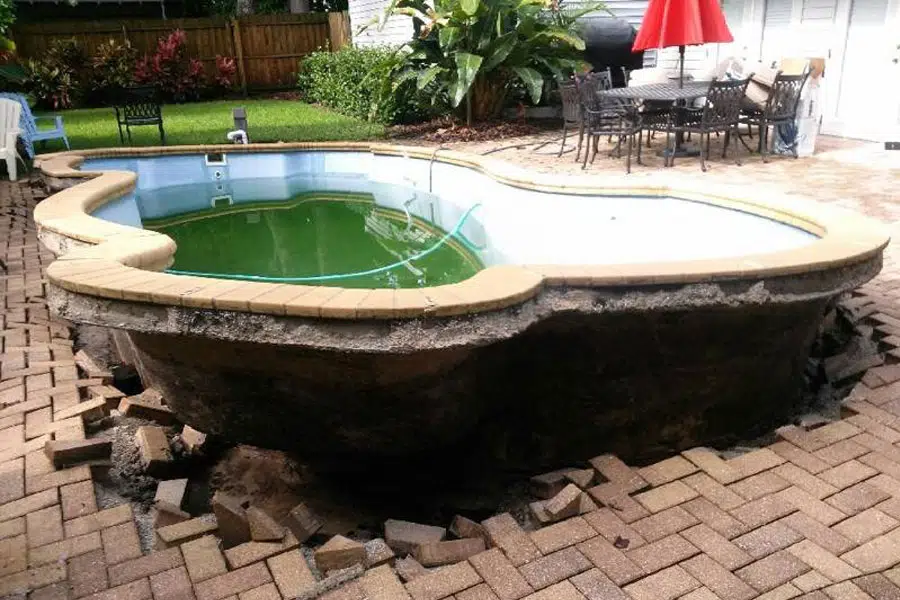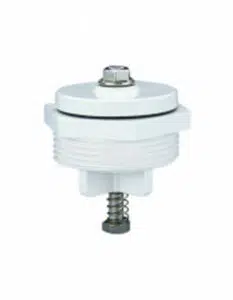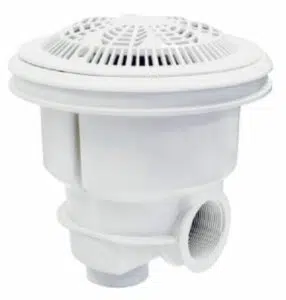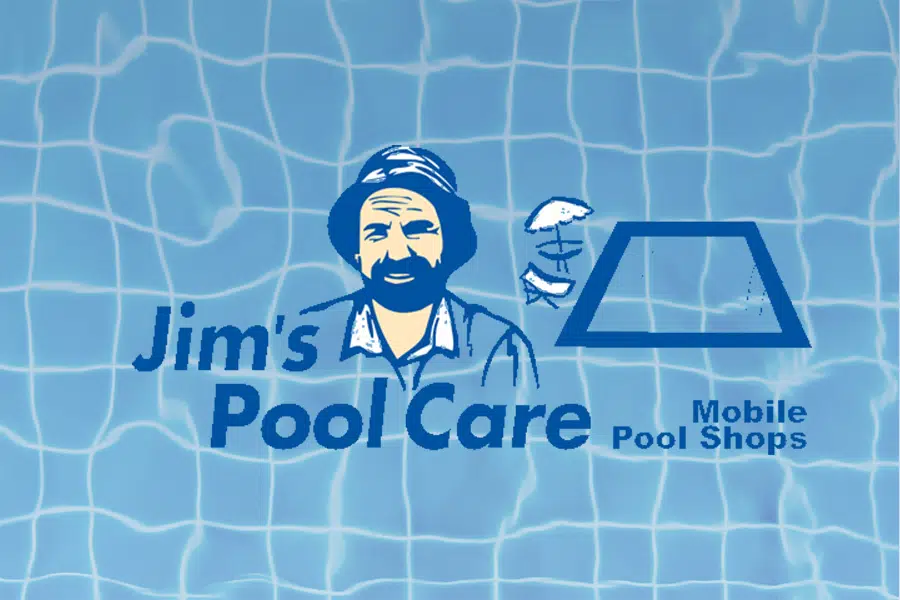
How did this in-ground pool end up as an above ground pool?
*If your swimming pool is green or in need of a clean up do not drain it as your first option, Jim’s Pool Care can help.
In this article, we are going to break down a couple of things to understand about swimming pools, to ensure your pool doesn’t end up like this now ‘above ground’ pool. The first mistake can come from the process of draining a pool of it’s water completely without careful planning.

Draining a swimming pool can be risky, problematic and should only be done only when absolutely necessary. Why? Because swimming pools are always meant to be filled with water, they are designed and built to have a massive amount of weight. Most green pools can be recovered by a professional, trained pool technician (think Jim’s Pool Care), by using chemicals and hard work alone, without risking your pool popping out of the ground.
The heavy weight of the water keeps the pool in place. Removing water from a swimming pool can cause serious damage to pool walls, floors and liners if not done correctly or done at the right time. Imagine a fibreglass pool under the weight of pool water for years, suddenly being drained. This can cause it to ‘pop’, “crease”, crack or even lift out of teh ground if there is ground water underneath it.
In some instances, pools have been know to ‘pop’ out of the ground or shift, while others may cave in. There may also be damage to decks or paving surrounding the pool, wiring as well associated equipment such as plumbing, lights and in-floor cleaning systems.
Often the issues are with the lighter construction of fibreglass pools and vinly liners pools, but it can happen to concrete constructions also.
POOL HYDROSTATIC VALVES
There are water tables running underground all over the country. Because we don’t know exactly where they are, pool builders now take the precaution to plumb in a hydrostatic valve to the deepest point of every pool. It’s there in case you ever need to empty the pool. Without the weight of water that’s normally holding the pool down, any pressure pushing on an empty pool from an underground water table could pop the pool out of the ground or push it off it’s foundations.


The job of the hydrostatic valve is to react to any pressure and open up, which will allow the external water to run into the pool rather than push it over. The water will be dirty and messy, but it’s better than having your pool popped out of the ground. This can happen even when the pool is full of water due to the pressure of ground water, hence the important of a working hydrostatic valve.
It’s also imperative that it works whenever you might need it, so don’t be alarmed if we ever suggest to you that it should be replaced.
POOL STANDPIPE
Some (Fibreglass mostly) pools may have an inspection pipe(s) near the pool, usually just near the pool edge. These would have been installed at the time the pool was placed in the ground to check ground water levels near the pool.
Standpipes are usually closed off with something like a shower grate to stop too much rubbish filling them up. You can usually check the ground water level by inserting a thin dowel or stiff wire down and then measuring the depth. As a guide if the water level shows as being LESS than about 1.5 to 1. 8 M below ground level, be careful when emptying the pool. It may cause movement or bulges.
There are risks to draining a pool. In this regard, some contractors prefer not to empty a pool themselves but provide advice or guidance to the customer to do this themselves only for the contractor to return to undertake works. This may be seen as professional advice and could have legal implications for contractor if the customers pool is damaged based on advice they proved to the customer.
RISK Vs REWARD OF DRAINING A SWIMMING POOL
Whilst draining a pool may be required in some instances, it is not normally required nor recommended as routine practice.
A risk assessment of a pool and its surrounds should always be done before accepting a job, providing a quoting or draining. If in doubt, do not proceed and seek out expert advice.
If you are not sure – do not proceed and seek out professional advice. The profit gained from undertaking an acid wash or other similar works is negligible if things turn bad due to poor planning, practice or negligence.
KEEPING POOLS IN THE GROUND
- Do not drain a pool during extended periods of heavy rain
- Ensure that the Hydrostatic Valve is working before you start draining
- Pump any discharge into the *sewer or *storm water (*check with your local council for rules and it can be different from state to state)
- Make sure pool is sufficiently braced or OK’d by expert before draining
- Drain water slowly and monitor
- Once drained, work as fast as you can. Do not leave pool unattended and refill as soon as possible.
- Make sure your insured as even an expert approach can turn bad
DISCLAIMER:
This communication contains information and data prepared by SPASA Australia. The information and advice published or made available through SPASA Australia is provided for your general information only. Every swimming pool or spa installation is different and pool and spa builders, service technicians and other professionals should seek independent expert advice in relation to a particular pool or spa installation. The information contained in the document is provided for informational, educational and learning purposes only and is not a substitute for professional advice.
Book Two Classes for $2!
Get to know our studio before you commit to becoming a regular student. We can’t wait to meet you!
Client Testimonies











